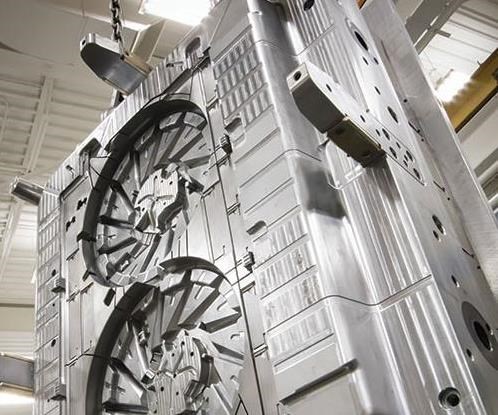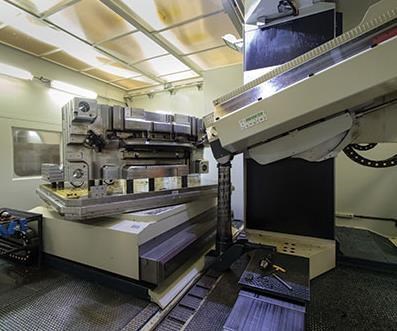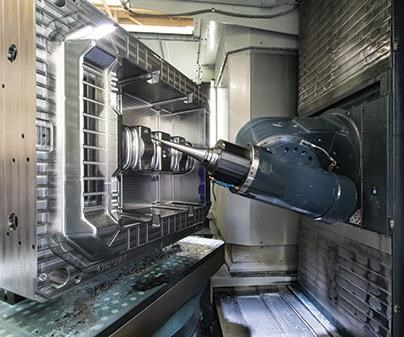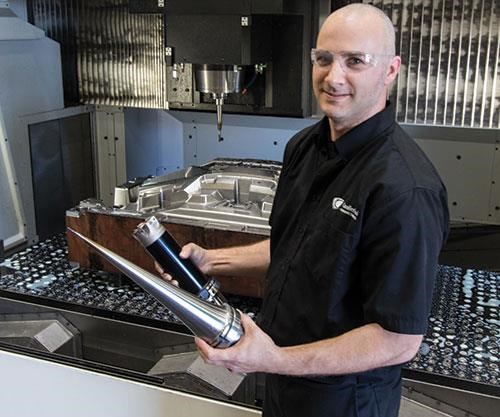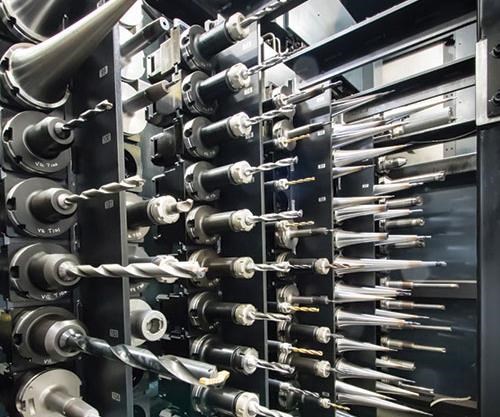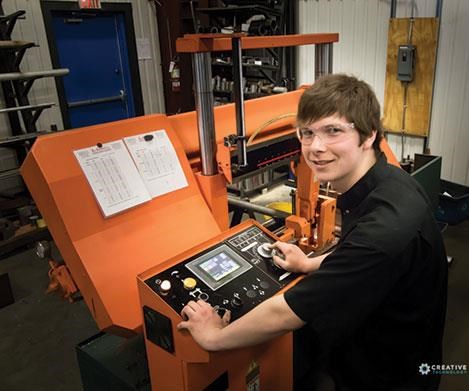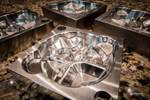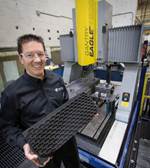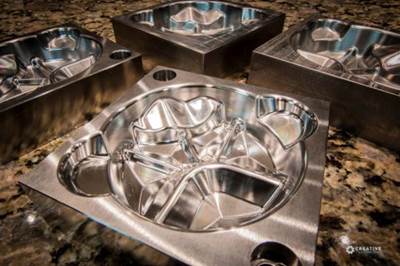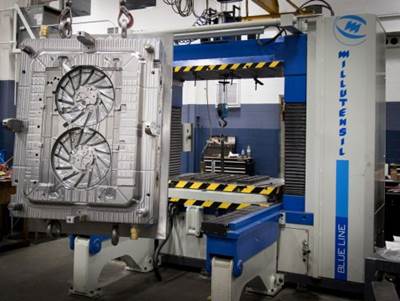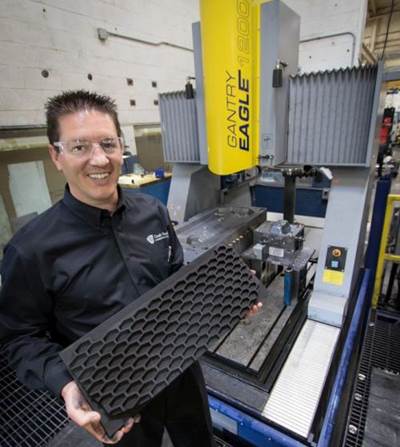2015 Leadtime Leader Awards Winner: Cavalier Tool & Manufacturing - Setting the Pace Holistically
This mold manufacturer has radically transformed its business by instituting a standardized, flexible process, advanced technology and a people-centric philosophy.
Cavalier Tool & Manufacturing has big plans for its new EDM cell. As this article began to take shape, the shop was preparing to install three large sinkers, all with high-capacity electrode changers, and a robot-fed, true five-axis machining center. Each standard workholding fixture will feature a radio frequency identification (RFID) tag to enable flexible storage and retrieval of all electrodes as needed, regardless of their locations within the cell. With part designs and tool paths completed well in advance, operators will simply load the EDM carousels and tables, choose a suitable program/job sequence and walk away, free to focus on bigger-picture, more value-added activities.
With the capability to run completely unattended for days on end, the new cell is expected to significantly expand capacity and efficiency without adding to labor costs, says Brian Bendig, company president. These gains will make it the apex of an ongoing transformation at this Windsor, Ontario, mold manufacturer, which has completely reinvented itself during the past five years. The cell’s technology, the process it embodies and its expected effect on how people approach their work also make it a microcosm of this broader transformation.
In fact, a three-part focus on people, process and technology is formally codified into the shop’s business philosophy. Bendig and the rest of the leadership reason that pursuing continuous improvement in all three areas is the best way to not just keep up in a highly cyclical, constantly evolving industry, but to set the pace.
All indications are that Cavalier is doing just that. In a little more than five years, annual sales have increased from $8 million to $24 million and continue to climb. An increasing amount of revenue comes from new customers in the automotive industry, historically a nonstarter for the shop but now its fastest-growing segment of business. All in all, the company is closer than ever to the vision that Bendig first laid out in the waning years of the previous decade—close enough to earn the 2015 Leadtime Leader Award.
Aiming High
Bendig’s vision began to take shape circa 2007. By that point, Cavalier enjoyed a long-standing reputation for quality on mid- to large-sized molds for recreational vehicles, heavy trucks and commercial products. Efficiency-wise, however, the shop had begun to fall behind the competition. Bendig, who was vice president at the time, began regularly travelling the globe in search of new technologies, techniques and production philosophies. His goal was ambitious: to place Cavalier in the top tier of North American mold manufacturers.
The lessons he brought back are easy to spot these days. This is a shop that sticks to what it does best: building molds. There are no fixture-building services or sampling presses here, and the company devotes time and resources only to the most difficult work. In that arena, building a better mold than the competition means never cutting corners (engravings are always done on CNC rather than stamped, for example) and never compromising on technology. Quality and overall value rule at Cavalier, and price is simply not a priority, whether for selling a mold or purchasing a machine. In fact, the shop accepts work from certain well-known customers without ever quoting it. “We go after customers who need what we can provide, not those who want what we can provide,” Bendig explains.
Earnest efforts to implement these principles began in 2009, when Bendig took ownership of the company his father founded with two partners nearly 35 years prior. That timing might seem less than ideal, but Bendig and crew weren’t going to let the economy stop them. “We chose to not participate in the recession,” he says. “We just asked ourselves what we’d need to succeed, and we went after it.”
Technology as a Differentiator
Updating technology was a top priority. Given the economic climate at the time, auctions presented an ideal opportunity to find quality, affordable manufacturing resources, and Cavalier purchased as much as it could. Still, Bendig refers to that machinery as “bridge equipment,” and for good reason: It was never intended to serve any purpose beyond laying the groundwork for what was to come. The shop that can remove the most metal the fastest and with the most precision wins the race, he explains, and for Cavalier, that race isn’t the local derby. It’s the proverbial Indianapolis 500.
Indeed, Bendig credits high-end machinery above all for the company’s ability to hold tolerances of 0.0002 inch across more than 80 inches of a surface. Such capability didn’t just open the door to the shop’s new focus in automotive work, which has grown from 16 percent of business two years ago to 46 percent today. It’s essential to maintaining an edge, particularly given Cavalier’s specialty in fans, shrouds and other “tolerance-critical, black plastic parts,” Bendig says. “If a machine can help us make a better mold—say, get water lines into areas where a competitor can’t—that’s a real differentiator,” he adds. “Some people might say they can’t afford it; we say we can’t afford not to have it.”
Once the shop was ready to move beyond temporary “bridge” equipment, Bendig’s aforementioned travels paid off. One notable example was his introduction to German machine tool builder OPS Ingersoll, which supplied Cavalier with one of the first Eagle-brand sinker EDMs in North America in 2012. Given the shop’s experience with that first machine, it’s no surprise that Cavalier is incorporating two more of those sinkers into its new EDM cell. “They burn fast, and there’s very little electrode wear,” he says, crediting adaptive current technology and a rapidly oscillating Z axis that ensures efficient flushing. “Within a year, that first machine saved us $126,000 in graphite, all the related cut time, plus the carbide used to make the electrode.”
In addition to raw capability, the company prioritizes technology that reduces labor by consolidating operations. Within the new cell, for example, the EDMs’ 30- and 48-position electrode changers and the Ingersoll Automation robot servicing the Ingersoll/OPS V9 high-speed machining center will limit the need for operator intervention. The V9 also employs true, simultaneous five-axis motion (not just 3+2). This is expected to enable cutting the vast majority of electrodes in a single setup.
The philosophies at work here have already proven their worth outside the cell, Bendig notes. High-capacity toolchangers and multi-axis machinery are common sights throughout the shop floor, as are pallet changers that enable operators to set up one job while another is in the workzone. “The best way to get labor out of the process is to never introduce it in the first place,” he says.
A Flexible, Standardized Process
The right equipment isn’t the only factor at work in consolidating operations. Cavalier’s design-driven process helps make the most of that equipment by ensuring efficient allocation of resources. Designs for any given mold are always at least 90-percent complete before the shop ever cuts a chip, Bendig says. This maximizes flexibility because the order of operations can change based on capacity to keep work flowing. For example, gundrilling operations might occur prior to roughing if the required machining center is tied up.
A design-centric approach also improves process predictability and consistency by reducing the potential for variation during manufacturing. Consider the new EDM cell, which will employ standardized fixtures from Erowa to ensure proper orientation and location repeatability as graphite moves from robot to machining center and from electrode changer to EDM chuck. Such a system is capable of executing a pre-programmed sequence of operations virtually indefinitely and with the exact same result every time, barring mechanical wear or some external influence. Human beings could never be so precise or repeatable, Bendig says.
Sourcing all machines in the cell from the same builder is also an example of the shop’s broader drive toward standardization. Dealing with the same essential machine configuration, CNC interface, burning parameters and so forth is far easier than getting used to multiple systems, Bendig says. Employees can also fill in for one another more easily when required.
This strategy is at work beyond the new cell, too, and it extends to options and auxiliary equipment. All CNC equipment features coolant-through spindles, laser
tool gaging, touch probes, standardized workholding and, where possible, a standardized selection of cutting tools. Common machines with common capabilities improve throughput by making performance more predictable and scheduling more flexible, Bendig says.
Yet, these strategies did nothing to alleviate what was once one of Cavalier’s chief hurdles. Historically, the ebb and flow of business often left the shop scrambling to keep up one week and contemplating the need to cut shifts the next. To address this problem, Cavalier employs strategic, highly selective partnerships to flex capacity as needed. This helps maintain a steady workload (and steady employment), regardless of business conditions.
More specifically, the manufacturing floor runs 24/7, and the shop strives to maintain a workload that is more than it can handle. Typically, the goal is 110 percent capacity. During busy periods, that extra 10 percent can be outsourced to partners. When business slows, the shop can bring the work back in-house to keep its spindles running and its people busy. In keeping with Cavalier’s philosophy of sticking with what it does best, outsourced work tends to involve less cost-effective portions of the build. However, as the shops grows and changes, so do its bottlenecks. For instance, Cavalier has been performing far more gundrilling since the addition of two large, five-axis MF 1500BB models from I.M.S.A.
A People-Centric Approach
Transitioning to new technology and new processes has had a profound effect on how shopfloor personnel do their jobs. With the fully automated EDM cell, for example, staffers
will act “more like overseers,” Bendig says. Recognizing the potential difficulty of such a transition, the shop has made efforts to keep employees happy, engaged and productive from the very outset. These efforts to make Cavalier a good place to work have succeeded, judging from an annual turnover ratio of less than 6 percent.
Much of this success stems from a dual focus on engagement and transparency. As for the latter, regular “state of the company” addresses from Bendig keep everyone informed about the bigger picture of the company’s performance and future outlook. “Nobody wants to follow someone that does not know where they are going,” he notes. Just last year, an outside consultant coached senior management on strategies to facilitate open, effective communication. That successful, two-month effort culminated in a day-long team-building exercise outside the shop.
Meanwhile, giving employees a real voice in the operation helps avoid the tendency to, as Bendig puts it, “put their brains in a toolbox before coming to work.” Despite the shop’s design-driven process, staffers are encouraged—and, as those closest to the work, even relied upon—to suggest process improvements. To that end, the shop has also instituted regular “job review” meetings in which the whole staff discusses what went right, what went wrong, and new ideas. Such feedback isn’t limited to just meetings, either. Bendig and his management team make a point to be out on the floor and available to engage with staffers as often as possible.
Keeping communication open has been critical to building the right team. Indeed, one of the first orders of business when Bendig took ownership was, as he puts it, “getting the right people on the bus, then getting those people into the right seats on the bus.” The right people, he explains, are critical thinkers who are willing to try new things and are comfortable with technology and processes that demand walking away from machines while they run. Even with the right attitude, however, a potential hire might be happier in one area of the shop than another. That’s why Cavalier takes personal preference into account when it comes to getting people into the right “seats” (for instance, a computer whiz is likely to be more comfortable with learning CAD/CAM software than learning how to operate a machine). As for long-standing employees, twice-yearly reviews help identify what they like and don’t like about their jobs and, by extension, whether a change might be in order.
Most new hires come in from the Ontario Youth Apprenticeship Program (OYAP), which has been a particularly good source of fresh talent in recent years, Bendig says. He attributes that to broader awareness among educators and government of the skills shortage, and the fact that young people appreciate the opportunity to work with the latest technology and processes. That said, Cavalier’s own efforts can’t be discounted. Bendig and his team commonly visit local schools, advise on technical curricula and sometimes even offer direct support, such as toolboxes to reward winners of technical skills competitions. They also host regular tours of the facility for students, parents, teachers, guidance counselors and administrators. In 2013, the company received an award from the Essex County Schoolboard for its support of the local education system.
Getting the Word Out
As evidenced by the shop’s efforts to re-invent the EDM department, Cavalier’s three-part transformation is far from over. In the meantime, the company has been working to get the word out about its capabilities and philosophy by redoubling efforts in sales and marketing.
Cavalier has long maintained a relationship with public relations firm Generator Design. In late 2014, however, the two companies embarked on a major push to expand advertising, social media engagement, targeted marketing, and presence at trade shows and other industry events. The shop’s message is targeted not just at prospective customers, but also the potential employees and supplier partners that Bendig views as critical to the company’s success. “We’re known as the Tylenol—we make it pain-free—and everyone wants to be on the winning team,” he says. “The more they find out, the more customers and suppliers want to work with us and the more people want to be employed here.”
Related Content
Dynamic Tool Corp: Leadtime Leader Insights and Bold Plans for the Future | MMT Chats
MoldMaking Technology Editorial Director Christina Fuges gets the scoop from our 2024 Leadtime Leader Award Winner Dynamic Tool Corp., on the company's future, their trade show experience, finding new talent and the impact of this industry recognition.
Read MoreSnapshot of Why Dynamic Tool Corp. is MMT's 2024 Leadtime Leader Winner
Here is a quick look at some of the reasons this 40-plus-year-old engineered tooling solutions provider took the title this year.
Read MoreMoldMaking Technology's Most-Viewed Content of 2024
The most popular MoldMaking Technology content according to analytics reports over the past year.
Read MoreNavigating New Product Development for Moldmakers
Strategies for moldmakers to effectively manage new product development projects, balancing customer expectations with technical realities.
Read MoreRead Next
Strategies for Evaluating, Maintaining Equipment
This year's Leadtime Leader award winner doesn't settle for just any test cut to evaluate a machine's capabilities. Once it does make a purchase, the shop's approach to ensuring those capabilities don't deteriorate is anything but cavalier.
Read More'Menu Pricing' Keeps Work on Track
This shop's strategy for pricing work not only helps eliminate midstream delays and disruptions, but also provides customers with extra flexibility.
Read MoreRFID to Deliver Material Cost Savings
The 2015 Leadtime Leader award winner expects this technology to offer more than just flexible retrieval of any EDM electrode or blank in a new, automated cell. It will also save on material costs and machining time by ensuring that any electrode can potentially be used for more than one application.
Read More


